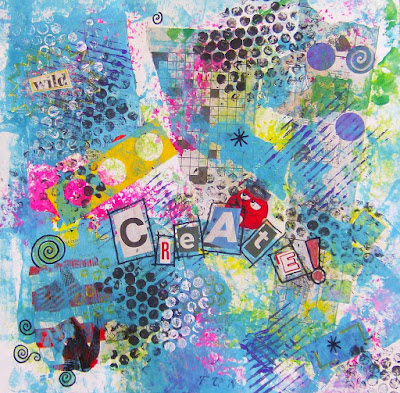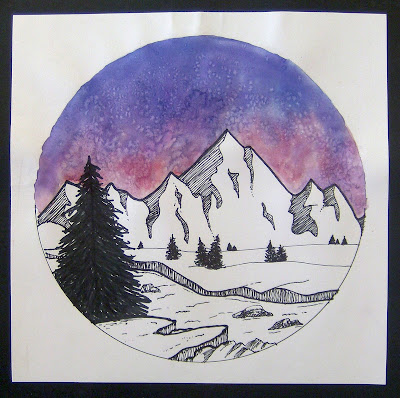
This beautiful mixed media artwork is created in the style of Jen Aranyi, a contemporary graphic artist and illustrator.
One of her favorite outdoor subjects is mountainscapes, such as these wintery art pieces created by our students in her style.

These watercolor and ink compositions can be created within non-traditional shapes such as triangles and circles. (Jen uses organic and animal shapes as well, but we decided to keep it simple for our first attempt.)
We started by deciding the shape that we will work within, which we drew lightly with a pencil using a ruler or by tracing a pie tin.
We then sketched in a jagged line approximately across the middle, making sure it wasn't too regular or zig-zaggy.

It needed to be uneven like the Sawtooths in Idaho. Then we filled in the sky with watercolor, wet-in-wet. We started with the lightest color along the top of the mountains and worked our way up, blending analogous colors and ending with our darkest color. Some added salt to the wet paint.
Once the paint was dry, we outlined the top of the mountains with our fine point Sharpie. Then we used our ultra-fine Sharpie to create rugged edges on each mountain peak. We learned to use hatching and stippling techniques to show shapes, textures, and shadows.
At this point, artists could choose to add a little stream or a depict a snow covered hilly landscape. Both were equally dramatic.
Next, evergreen trees were added to help to create the illusion of distance. Notice the most of the distant trees are mere dots!
We then traced a Sharpie line around the bottom of the circular compositions, and we erased any pencil marks with a big soft eraser. Those who did not add salt now used white acrylic paint on the tip of a skewer to add stars to the sky. Then, after everything was dry, we cut out the triangular pieces and we mounted all of our artwork on black poster board for added emphasis.
Jeanette created the mountainscape below in her art journal
using soft pastels to add color her sky.
These last four, shown below, are my samples/demos.
(Okay, YES, I admit it! I really LOVE making these!)
These works of art were created by artists ages 6 through adult.



















































